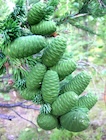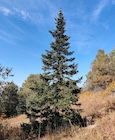
(both subspecies)
Abies sibirica
Ledeb. 1833
Common names
Пихта сибирская (pikhta sibirskaya) [Russian]; 西伯利亚冷杉 xian bei leng shan [Chinese]; Siberian fir [English].
Taxonomic notes
This is one of the northern firs, belonging to Abies section Balsamea, a Holarctic group that has experienced repeated major changes in distribution during the Pleistocene. Nuclear DNA place it sister to E Asian Abies in a clade comprised of A. koreana, A. nephrolepis, A. sachalinensis, and A. veitchii (Semerikova et al. 2018). There are two subspecies, the type and Abies sibirica subsp. semenovii (B. Fedtsch.) Farjon 1990; the sister relationship between these taxa was confirmed by Semerikova and Semerikov (2016). The two taxa are morphologically very similar, but there are genetic arguments for treating subsp. semenovii as a distinct species (Semerikova et al. 2012, Orlova et al. 2016), besides which it has a disjunct range and perhaps has ecological distinctions as well. Regardless, the two taxa are each others' closest relative. There is also a widespread natural hybrid found in China: Heilongjiang, Abies × sibirico-nephrolepis Taken. et Chien 1957 (Farjon 1998).
Synonymy for subsp. sibirica (Farjon 1998):
- Pinus sibirica (Ledeb.) Turcz. non Du Tour
- Pinus picea Pall. non L.
- Abies pichta J. Forbes
- Picea pichta (J. Forbes) Loudon
- Pinus pichta Fisch. ex Endl.
Synonymy for subsp. semenovii (Farjon 1998):
- A. semenovii B. Fedtsch.
- A. sibirica var. semenovii (B. Fedtsch.) Liu
Description
Monecious evergreen trees to 35 m tall and 100 cm dbh, usually with a single trunk and conical crown, but older individuals often develop multiple crowns. Bark gray-green, smooth, with many resin blisters. Twigs yellowish-gray, shiny, slightly tomentose. Foliage buds globose, greenish, small, resinous. Leaves directed forwards, pectinate in shade foliage, adaxially light green, soft, pliable, flattened, (1.5-)2-3(-4) cm × 1-1.5 mm, apex acute, rounded or notched, stomata in 2 abaxial whitish bands, occasionally stomata on distal adaxial surface. Seed cones cylindric, 5-9.5 × 2.5-3.5 cm, blue maturing brown. Seed scales at middle of cones obtriangular-flabellate or flabellate-trapeziform, usually slightly contracted at middle, 1.7-2.5 × 1.6-2.4 cm, exposed part densely pubescent abaxially, base pedicellate. Bracts concealed, cuneate-obovate, 1/3-1/2 as long as seed scales, distal margin erose-denticulate, apex slightly rounded. Seeds slightly appressed, obtriangular, ca. 7 mm; wing light blue distally, cuneate, 0.7-1.3 cm. Cotyledons 3-4. Pollination May, seed maturity Oct-Nov (Vidakovic 1991, Wu and Raven 1999).
Specimens with green immature cones have been described as forma chlorocarpa Wilson. Subsp. semenovii differs from subsp. sibirica in having prominently ridged and grooved (rather than smooth) twigs, in having only slightly resinous buds, and in having seed cones that mature yellowish-brown rather than bluish-brown (Farjon 2010; see Orlova et al. [2016] for much more detailed discussion). In Heilongjiang, China, this species hybridizes with Abies nephrolepis: Abies × sibirico-nephrolepis Takenouchi et Chien. The hybrid has shorter leaves, the young shoots are grey-brown pubescent, and the cones are larger; other characters are intermediate between the two species (Farjon 1990).
Distribution and Ecology
The two subspecies have disjunct ranges. Subsp. sibirica occurs in Kazakhstan; Kyrgyzstan; Russian Federation: Altay, Amur, Buryatiya, Chita, Irkutsk, Khabarovsk, Krasnoyarsk, Tuva, West Siberia, Yakutiya. As such, this is the most widely-distributed Abies in the world, and also occurs farther north than any other species in the genus. It occurs from near sea level in the northern taiga to about 2000 m elevation in the mountains, mostly on mildly acidic alluvial soils but sometimes on carbonates in the mountains. Climate is cold continental, and habitat is mostly closed forest mixed with other conifers (Larix gmelinii, L. sibirica, Picea obovata, Pinus sibirica) and deciduous angiosperms (most commonly Betula pendula, Populus tremula, Sorbus aucuparia, Viburnum opulus) (Farjon 2010). Hardy to Zone 1 (cold hardiness limit below -45.6°C) (Bannister and Neuner 2001), which makes it one of the most cold-hardy trees known. The species is also widely introduced as an ornamental in western Europe, and has become naturalized in much of Scandinavia, where it regenerates easily; its habitat and associations here are similar to those of the taiga.
Subsp. semenovii occurs in Kyrgyzstan (and possibly extreme western China: Xinjiang), growing in the western Tian Shan mountains, the Chatkal Range, the Talas Ala-Too, and the Fergana Too Tizmegi, at 1350-2800 m elevation. Here it forms extensive forests with Picea schrenkiana; other associates include species of Acer, Betula, and Sorbus, and at high elevations, Juniperus pseudosabina, J. sabina, and J. semiglobosa (Debreczy and Racz 2011).
Distribution of Abies sibirica. Subspecies sibirica shown in blue, and subspecies semenovii in green. Extralimital occurrences shown in gray are primarily naturalized from European plantations of subsp. sibirica, but some may represent plantation or ornamental individuals. Distribution data from GBIF, 2024.01.27.
Both subspecies are separately assessed as "Least Concern" for conservation. For the type subspecies, this is well supported due to its enormous range and population size, but subsp. semenovii has a much smaller range that has not been quantified, and has been identified as a species of conservation concern in many different assessments going back to 1975 (Orlova et al. 2016). The last IUCN conservation assessment (Zhang et al. 2011) simply concludes "no evidence to suggest that Abies sibirica ssp. semenovii is under a current significant threat, hence it is listed as Least Concern." This seems a conclusory argument, and Semerikova et al. (2012) found evidence of very low genetic variation with long-term population declines. Orlova et al. (2016) report that "over the past two centuries, it has been under increasing anthropogenic pressure and it occupies nowadays an area of only about 3470 ha and pure stands are very rare. The main threats are from felling and cattle grazing." They also cite past studies providing a more detailed inventory of threats to the species and prioritizing areas for conservation and preservation. Realistically, the species should be regarded as "Vulnerable" or "Endangered", and given the absence of any conservation efforts or reserves to protect the taxon, the latter seems more appropriate.
Recent extensive forest dieback in Abies sibirica and Pinus sibirica forests of southern Siberia (50-56 degrees latitude) has been shown to not be tied to increased water stress, and in fact current climate change models forecast little effect on these forests in the 21st century. Observed dieback may be due to air pollution, but more study is needed to elucidate causes (Tchebakova et al. 2022).
Remarkable Specimens
The height record, 40.5 m, belongs to a cultivated tree at the Finnish Forest Research Institute in Punkaharju, Finland. Measured July 27, 2012 by Kouta Räsänen and Esko Oska, the tree is 67 cm dbh (Räsänen 2012). Vladimir Dinets (e-mail 1998.01.02) reported a tree in habitat 39 m tall at Teletskoye Lake, Altai Mts, Russia.
Very old specimens are not known. I have not found any cited references to trees more than 150 years old, and Vidakovic (1991) asserts that "this fir never exceeds an age of 150 to 200 years due to rot that sets in the wood."
Ethnobotany
Abies sibirica is extensively planted in northern Europe, particularly in Scandinavia and neighboring Russia, and within its native range. Essential oils from its foliage are steam distilled for aromatherapy, perfumery, and related uses (Anonymous 2000). The timber is harvested for poles and pilings, mine props, framing, general lumber, tonewood, and for pulp. Lacking resin canals, it is attractive in finish carpentry but has fairly low decay resistance. Sometimes it appears as a plantation tree (especially a Christmas tree), but mainly it is a popular ornamental. Ornamental uses for the species include at least 17 named cultivars (pictured at the Russian Conifer Society [2024], with more good photos at САДиК).
Observations
No data as of 2024.01.27.
Remarks
"It prefers cool and and moist climate. Although extremely resistant to frost, in Yugoslavia it is subject to late frost injury. Gases will also inflict serious damage. Propagation is by seeds and rooting of lower branches" (Vidakovic 1991).
Citations
Anonymous. 2000. Pine needle oil (Abies sibirica Ledeb.) Siberia. www.execpc.com/~goodscnt/data/es1005151.html, accessed 2000.03.16, now defunct.
Debreczy, Zsolt and Istvan Racz. 2011. Conifers Around the World. Budapest: Dendropress Ltd.
Farjon, Aljos. 1990. Pinaceae: drawings and descriptions of the genera Abies, Cedrus, Pseudolarix, Keteleeria, Nothotsuga, Tsuga, Cathaya, Pseudotsuga, Larix and Picea. Königstein: Koeltz Scientific Books.
Farjon, Aljos. 2010. A Handbook of the World's Conifers. Leiden, Netherlands: Brill Academic Publishers.
Orlova, Larisa, Gennady Firsov, Alexandr Egorov, and Alexandra Volchanskaya. 2016. Abies semenovii in North West Russia: taxonomy, ecology, cultivation and conservation. Dendrobiology 75:131-139.
Räsänen, K. 2012. Siberian fir on the corner of Finlandiantie in Laukansaari. www.monumentaltrees.com/en/fin/southernsavonia/punkaharju/4456_finlandiantie/, accessed 2012.02.24. Includes a photo of the tree.
Semerikova, S. A., M. Lascoux, and V. L. Semerikov. 2012. Nuclear and cytoplasmic genetic diversity reveals long-term population decline in Abies semenovii, an endemic fir of Central Asia. Can. J. For. Res. 42:2142–2152.
Semerikova, S. A., and V. L. Semerikov. 2016. Phylogeny of firs (genus Abies, Pinaceae) based on multilocus nuclear markers (AFLP). Russian Journal of Genetics 52:1164–1175.
Semerikova, S. A., Y. Y. Khrunyk, M. Lascoux, and V. L. Semerikov. 2018. From America to Eurasia: a multigenomes history of the genus Abies. Molecular Phylogenetics and Evolution 125:14–28.
Tchebakova, Nadezhda M., Elena I. Parfenova, Elena V. Bazhina, Amber J. Soja, and Pavel Ya. Groisman. 2022. Droughts are not the likely primary cause for Abies sibirica and Pinus sibirica forest dieback in the south Siberian mountains. Forests 13(9):1378. https://doi.org/10.3390/f13091378.
Zhang, D., K. Rushforth, and T. Katsuki. 2011. Abies sibirica subsp. semenovii. The IUCN Red List of Threatened Species 2011: e.T34144A9844108. https://dx.doi.org/10.2305/IUCN.UK.2011-2.RLTS.T34144A9844108.en. Accessed 2024.01.27.
See also
Description, photographs, cultivars and cultivation advice at the SADiK site, headquartered in Tomsk, Russia (where this species is local).
Elwes and Henry 1906-1913 at the Biodiversity Heritage Library. This series of volumes, privately printed, provides some of the most engaging descriptions of conifers ever published. Although they only treat species cultivated in the U.K. and Ireland, and the taxonomy is a bit dated, still these accounts are thorough, treating such topics as species description, range, varieties, exceptionally old or tall specimens, remarkable trees, and cultivation. Despite being over a century old, they are generally accurate, and are illustrated with some remarkable photographs and lithographs.
Farjon (2010) provides a detailed account.





